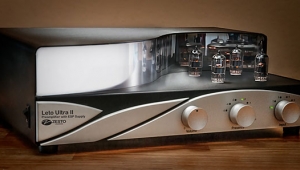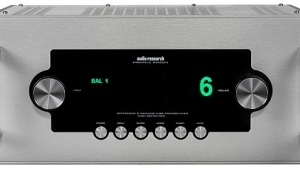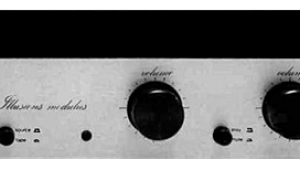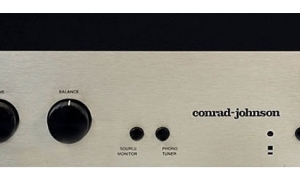| Columns Retired Columns & Blogs |
McIntosh C1000 preamplifier system
Still burning in my bank of childhood memories are misty images of the glowing green lettering on the McIntosh tube preamps and tuners that populated the windows of the audio stores that once lined lower Manhattan's Cortlandt Street. Leonard's and most of those other retailers are long gone—as are most of the audio brands that shared their windows with McIntosh, and that once symbolized the might of American innovation and manufacturing. Even the World Trade Center, the controversial complex that replaced Cortlandt Street's "Radio Row," where the hi-fi industry was born, is tragically gone.

Yet McIntosh Laboratory, Inc., still based in Binghamton, New York, survives—as do the glowing green lettering behind glass and the mint-blue backlit meters that adorn most of their new components, all of which now look retro-cool. You have to love that.
Once owned by Clarion, a Japanese firm known for its inexpensive car stereos, McIntosh was acquired in 2003 by another Japanese company, D&M Holdings, which also owns Denon, Marantz, Boston Acoustics, and Snell. You and I collect audio components. These guys collect audio-component companies.
From the time I saw my first McIntosh preamp until I got to hear one at home took 46 years. But who cares about the delay when my first Mac is the outrageous, totally over-the-top bling-bling of the three-box C1000 preamplifier system? It's got three sets of glowing green lettering behind glass, two sets of meters—even a row of tubes glowing sexily in a "storefront" window complete with a ceiling mirror that doubles the visual drama. And it costs only $26,000.
The three-box solution
Why argue over whether tubes or solid-state sounds better when you can have both? The C1000 consists of the C1000C controller/power supply and two separate, fully balanced preamplifiers, one solid-state, one tubed. One needn't buy both preamps to go with the C1000C controller, but I'd bet 100% of buyers plunking down $17,000 for the controller ($8000) and one module ($9000) opt for both, for that total of $26,000.
The C1000C controller has knobs for Volume, Balance (remember that?), Source selection, and the Record Out selector, and provides power and control signals to one or both preamplifiers via individual umbilical cords for each channel of each preamp.
Aside from the amplification methodology, the C1000T (tube) and C1000P (transistor) preamps are identical, offering nine sources each, including both moving-coil (MC) and moving-magnet (MM) inputs. There are three sets of balanced inputs and four sets of unbalanced, not including the unbalanced MM/MC inputs. Three sets of balanced outputs allow for convenient triamping, if you're so inclined. Two unbalanced outputs allow for biamping in unbalanced mode. Because each preamp has its own inputs and outputs, double runs of cables are required for each amplifier channel, for a total of four for a conventionally amplified system, or twelve cables for a balanced triamplified stereo system. Both preamps convert unbalanced signals to balanced, and vice versa. Each preamp has a headphone jack mounted in the center of its front panel.
McIntosh's balanced power amplifiers, intended for use with the C1000, have two balanced inputs. McIntosh supplies combiner modules for single-input balanced amps. These also allow two balanced inputs to be converted to three, allowing for a long pair of balanced cables for each channel to be run from the preamplifiers, and, for each channel, short runs from the modules to the three amplifiers of a triamped system.
Once you've got the C1000 talking to your amplifier, it's time to connect your balanced and unbalanced source components, which can be used simultaneously. Which to connect to the tubed preamp and which to the solid-state? Your choice. The only way to find out which you prefer is to try both. However, thanks to a balanced recording link, you can get the record-out signal (balanced and/or single-ended) from either preamp's Record Out jacks.
With everything connected, it was time to power up. The C1000 is mighty handsome even when turned off, but oh my—nothing in my experience has looked any cooler or more elegantly blinged-out than these three boxes with their lights on and mine off.
What's inside
Aside from its dual-mono power supplies, the C1000C controls the signal routing and source selection for the preamplifier modules. When other McIntosh components are connected to the C1000's data ports, basic control functions are automatically handled by the remote control; turning the C1000 on or off with the remote turns all connected McIntosh gear on or off.
The C1000C's volume control is a digital optical encoder: as the knob is rotated, two internally mounted sensors receive a beam of infrared light as a series of digital pulses. A microprocessor counts the number of pulses to control a McIntosh-designed electronic attenuator that provides 213 steps in 0.5dB increments while maintaining channel balance to within 0.1dB.
While most preamplifiers use a single volume control placed ahead of the gain stage, McIntosh says that while this results in wide dynamic range and freedom from overload, noise increases as the volume is lowered. Lower background noise can be achieved by placing the volume control after the gain stage, but at the expense of dynamic range and the ability to prevent input overload. McIntosh's solution is to use two volume controls, one before the gain stage and one after; they claim that this results in wide dynamic range, freedom from input overload, and an impressively low noise floor of –118dB. The two volume controls are linked together and controlled by what McIntosh calls a Dynamic Control Multiplexer.

There is a separate Mute button; when you mute the C1000, the sound stops suddenly and completely, though it ramps up pleasantly when you want to listen again. I liked that feature.
For the C1000, McIntosh's engineers developed a new, fully shielded, low-noise MM/MC phono preamplifier that can handle medium-low-output (0.45mV) MC cartridges without needing a step-up transformer. Ultralow noise is claimed, thanks to the shielding and a dedicated double-filtered power supply. Both the tubed (four 12AX7s) and solid-state phono preamps are specced equally in terms of MM/MC input sensitivity, though the solid-state model's signal/noise ratio is 88dB to the tubed version's 80dB. Both offer the same loading facilities: for MM, 47k ohms, with 50–750pF in steps of 50pF; for MC, 25, 50, 100, 200, 400, or 1000 ohms, in parallel with 100pF.
Setup and programming
The C1000C controller's Setup mode (push the Setup button) will confound audiophiles used to straightforward plug-and-play preamplifiers. (Thank goodness I've set up and programmed home-theater receivers.) While you can operate the C1000 with its factory default settings, it makes more sense to take advantage of its flexible configurability. In fact, for certain functions, you'll have to. Within Setup mode, the Listen, Balance, and Record buttons assume fresh identities that can be confusing if you're not careful. It's easy to get lost in the maze of possibilities, and once you've made a change, it's easy to forget what you did, and damned difficult to figure out how to get back to where you once were.
At one point, I auditioned the latest version of Merlin's VSM loudspeaker for a Follow-Up review. Programming the C1000's processor loop so it would pass through the unit's electronic BAM bass equalizer was a nerve-racking experience requiring the combined brain power of three not-stupid individuals. The instructions try to be explicit, but too few examples are provided—and if you don't get it right, you get no sound.
- Log in or register to post comments




































